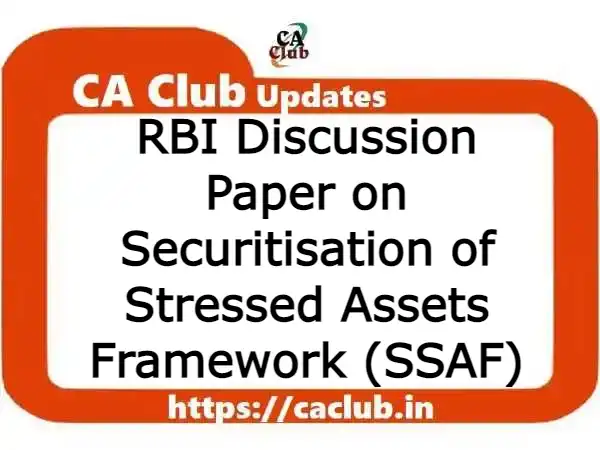In accordance with RBI announcement of September 2022 on the proposed “Securitization of Stressed Assets Framework (SSAF),” a ‘Discussion Paper’ has been released, inviting comments from stakeholders.
Comments may be submitted up to February 28, 2023, by e-mail, with the subject line “Discussion Paper on Securitization of Stressed Assets Framework (SSAF)”, or by post addressed to,
The Chief General Manager,
Credit Risk Group,
Department of Regulation, Central Office,
Reserve Bank of India,
12th Floor, Central Office Building,
Shahid Bhagat Singh Marg,
Fort, Mumbai – 400001
The Discussion Paper touches on nine important aspects of the framework in a general sense. These aspects include the asset universe, asset eligibility, minimum risk retention, regulatory framework for special purpose entities and resolution managers, access to finance for resolution managers, capital treatment, due diligence, credit enhancement, and valuation. The following is a list of all 13 questions that have been posed by RBI for debate and comments:
1. Should the SSSAF only include NPAs, or should it also include standard assets up to a certain threshold? You may also elaborate on relevant implications, such as regulatory arbitrage, complexity, impact on resolution strategy and effectiveness, potential thresholds, and so on.
2. Which types of assets should be eligible for stressed asset securitization, namely term loans only with the same asset universe as in standard asset securitization; big-ticket loans above a certain aggregate threshold (e.g., Rs. 100 crores); or small ticket loans such as commercial and residential mortgages, loans to MSMEs, and unsecured retail assets with a floor on pool specifications such as minimum number of loans, ticket size, cumulative loan amount, etc.
You must provide comments with a qualitative or quantitative rationale, as well as your thoughts on the likelihood of resolvability under the chosen option(s).
3. Is it necessary for SSAF regulations to specify the form and amount of the Minimum Retention Ratio (MRR)? If so, should the MRR stipulation be the same as for SSA, or should it be different in terms of quantum or form? Furthermore, who is responsible for meeting the MRR requirement: the resolution manager, the originator, both, or other parties? Your explanation should be in your comment.
4. Does the concept of an independent resolution manager give rise to any conflicts or arbitrations, whether they be prudential, economic, or any other kind?
5. Should the SSAF explicitly prohibit any form of interaction between the originator and the Resolution Manager once the stressed assets have been transferred? or whether a relationship that is considered to be “arm’s length” should be allowed for a set period of time (let’s say three months), in order to enable a smooth transition and information exchange?
6. Taking into account, among other things, the requirement to report to authorities, which is the most appropriate regulatory framework should be used for the SPE and the Resolution Manager working under SSAF?
7. Within the purview of the RBI’s authority to exercise regulatory oversight, what kinds of corporate structures are open to consideration for the Resolution Manager? If the Resolution Manager needs to be a registered NBFC or ARC with the RBI? should RBI be concerned about anything as a result of this requirement? Please elaborate on your response, making sure to discuss both the legal and functional aspects of the structure that is being envisioned.
8. Should the Resolution Managers be authorised to borrow additional financing for the resolution of underlying assets from other lending institutions? If this is the case, what precautions should be taken?
9. Is the capital regime that is based on an external ratings-based approach (ERBA), and that is subject to a minimum NRPPD and RW floor of 100 percent, robust enough to capture the risks that are connected with the NPA securitization exposures? How should the NRPPD be built to strike a balance between the various factors? Should it be a graded NRPPD or a uniform NRPPD of, say, 50 percent?
10. Should the framework propose a lower NRPPD (for example, 30 percent), in order for it to be “qualified” under the framework, provided that the assets are sold promptly (thereby improving their recoverability prospects)? What should the necessary condition be, or how should it be protected, for such a dispensation? It would be helpful if your comment correlated with data on recoverability taken from the Indian context. Do any other realistic options for penetrating the Indian market exist, which could be taken into consideration?
11. In order for the investors or the resolution manager to complete their due diligence, will the proposed SSA framework be sufficient, or will major modifications to the same be required?
12. Which possibilities are available to be considered for the purpose of allowing credit enhancement? In addition, with regard to the process of resetting the credit enhancement, is there a particular facet that ought to be thought about while adhering to a regime that is analogous to the CE reset regime that is prescribed for SSA?
13. Does the proposed valuation regime adequately capture the risk that is connected to the securitization notes that have stressed assets as the underlying asset? Is there anything about the proposed arrangement that could be problematic from a financial or operational point of view, or from any other point of view? If your answer is yes, what other options are there besides the proposed regime?
RBI Discussion Paper on Securitisation of Stressed Assets Framework (SSAF) dt. 25/01/2023

Securitization is currently permitted only for standard assets, and lenders must rely on Asset Reconstruction Companies (ARCs) for stressed assets. The RBI initiative on the SSA framework will eventually result in the creation of another option for lenders to assist in the resolution of bad loans. Aside from the ARC route, the RBI has attempted to propose a completely new framework for troubled assets. I have high hopes that the proposed framework will be enthusiastically adopted by lending banks.